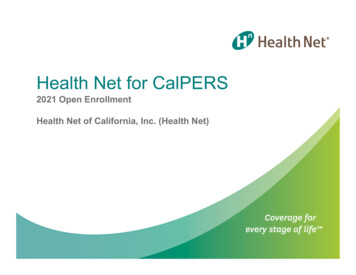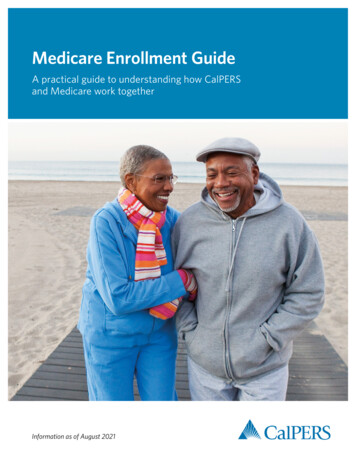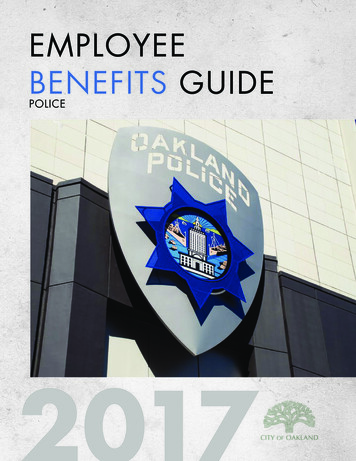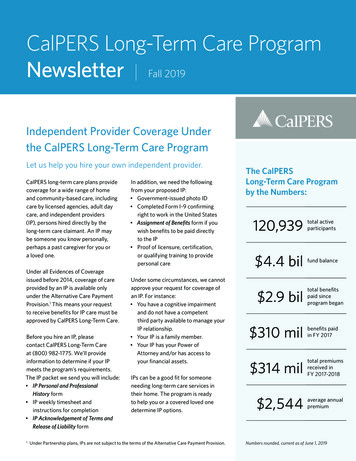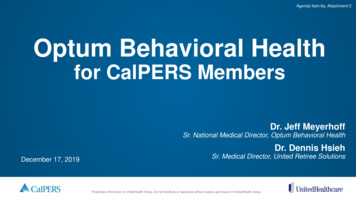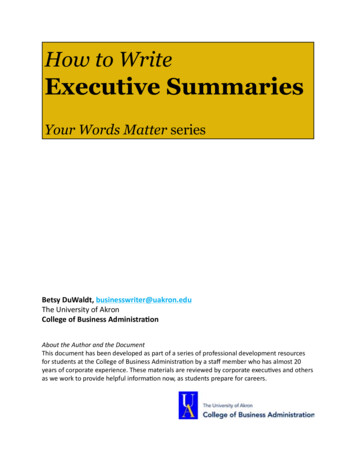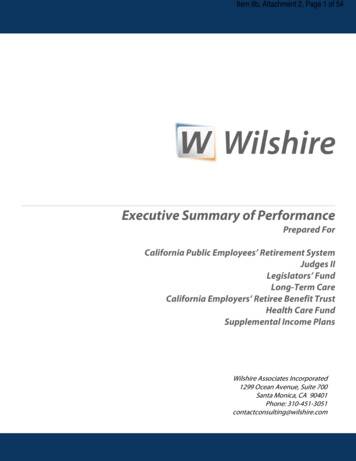
Transcription
Item 8b, Attachment 2, Page 1 of 54Executive Summary of PerformancePrepared ForCalifornia Public Employees’ Retirement SystemJudges IILegislators’ FundLong-Term CareCalifornia Employers’ Retiree Benefit TrustHealth Care FundSupplemental Income PlansWilshire Associates Incorporated1299 Ocean Avenue, Suite 700Santa Monica, CA 90401Phone: 310-451-3051contactconsulting@wilshire.com
Item 8b, Attachment 2, Page 2 of 54Wilshire ConsultingPerformance Analysis – June 30, 2018Prepared for CalPERSCapital Market OverviewU.S. Equity MarketThe U.S. stock market, represented by the Wilshire 5000 Total Market IndexSM, was up 3.83% for the second quarterof 2018, rebounding from only the second negative quarter in nearly six years. Volatility has returned this year butis approximately in line with long-term historical figures. Although there have been more up days than downduring 2018, the daily losses have been more substantial. The average daily loss has been approximately 34%greater than the average daily gain, a spread not seen in more than a decade. Trade and tariffs continued to helpdrive markets this spring as did increased anti-euro sentiment in Italy. Strong gains in personal income andconsumer spending during the second quarter have left room for optimism.Large capitalization stocks far underperformed small caps as the Wilshire Large-Cap IndexSM was up 3.41% versusa gain of 7.87% for the Wilshire US Small-Cap IndexSM. The large-cap segment of the market trailed small-capsfor the past twelve months, as well. The Wilshire US Micro-Cap IndexSM was up 9.21% for the quarter and 19.37%for the one-year. Growth stocks have been generally outpacing value except for the most recent quarter withinthe small-cap space, where value led growth.Sector performance was mixed with seven of the eleven major sectors producing gains. The best performingsector, by far, was Energy ( 14.2%) while Financials (-2.4%) and Industrials (-2.2%) were the main detractors fromtotal return.Fixed Income MarketThe U.S. Treasury yield curve rose across all maturities during the quarter with the biggest increases occurring inthe short to intermediate segment of the curve. The bellwether 10-year Treasury yield ended the quarter at 2.85%,up 11 basis points from March. The Federal Open Market Committee decided to increase its overnight rate by 25basis points in June to a range of 1.75% to 2.00%. There was little indication that the Fed is looking to changecourse and expressed generally strong sentiment towards the health of the economy. Credit spreads widenedduring the quarter within investment grade credit but were little changed for the high yield market.The shape of the yield curve is often considered when looking for signs of a potentially slowing economy. Acommon measurement of slope, the 10-year minus 2-year Treasuries spread, has been on the decline since late2013 and is currently below the long-term average at 0.38%. It should be noted that the last three times that thespread went negative (1989, 2000 and 2007) the U.S. economy entered a recession not long afterwards. While theshort end of the curve is directly linked to the Federal funds rate, the long end is driven by market activity.Continued economic growth without upward movement in long rates could be an indication that marketparticipants are expecting a slowdown on the horizon.
Item 8b, Attachment 2, Page 3 of 54Wilshire ConsultingPerformance Analysis – June 30, 2018Prepared for CalPERSNon-U.S. MarketsEquity markets outside of the U.S. produced mixed results during the second quarter of 2018 while currency hada major effect on U.S.-based investors. As global growth slowed and the Federal Reserve adopted a moreaggressive stance on interest rates, the U.S. dollar was up approximately 5% versus a basket of internationalcurrencies. Equity price volatility affected global markets as tensions seemed to escalate between the U.S. and itsmajor trading partners. It is yet to be seen, however, how much of the threatened tariffs and retaliation is actuallyimplemented. The European Union faces a fresh challenge with political developments in Italy, already beingrattled by the Greek financial crisis and Brexit in past years. The broad developed markets index, however, was inpositive territory for the quarter in local currency terms.Real Assets MarketsThe U.S. Treasury yield curve rose across all maturities during the quarter with the biggest increases occurring inthe short to intermediate segment of the curve. The bellwether 10-year Treasury yield ended the quarter at 2.85%,up 11 basis points from March. The Federal Open Market Committee decided to increase its overnight rate by 25basis points in June to a range of 1.75% to 2.00%. There was little indication that the Fed is looking to changecourse and expressed generally strong sentiment towards the health of the economy. Credit spreads widenedduring the quarter within investment grade credit but were little changed for the high yield market.
Item 8b, Attachment 2, Page 4 of 54Wilshire ConsultingPerformance Analysis – June 30, 2018Prepared for CalPERSSummary of Index ReturnsFor Periods Ended June 30, tic EquityStandard & Poor's 500Wilshire 5000Wilshire 4500Wilshire Large CapWilshire Small CapWilshire Micro 94Domestic EquityWilshire Large ValueWilshire Large GrowthWilshire Mid ValueWilshire Mid GrowthWilshire Small ValueWilshire Small 61International EquityMSCI All World ex U.S. (USD)MSCI All World ex U.S. (local currency)MSCI EAFEMSCI EuropeMSCI PacificMSCI Emerging Markets 216.925.012.54%5.462.842.363.952.26Domestic Fixed IncomeBarclays Aggregate BondBarclays CreditBarclays MortgageBarclays TreasuryCitigroup High Yield Cash PayBarclays US TIPS91-Day Treasury 0.35International Fixed IncomeCitigroup Non-U.S. Gov. BondCitigroup World Gov. BondCitigroup Hedged Non-U.S. 1.114.301.78%2.074.41Currency*Euro vs. Yen vs. Pound vs. 2.15-2.74-2.95%-0.44-4.02Real EstateWilshire REIT IndexWilshire Positive values indicate dollar depreciation.
Item 8b, Attachment 2, Page 5 of 54Wilshire ConsultingPerformance Analysis – June 30, 2018Prepared for CalPERSSummary Review of PlansPeriods Ended 6/30/2018TOTAL FUND for PERFTotal Fund Policy BenchmarkActuarial RateMarket Value 351.8 7.5%5-Year8.1%8.1%7.5%10-Year5.6%6.7%7.6% 39.7 mil0.5%0.5%1.5%1.4%0.9%0.7%0.5%0.4%0.5%0.4% 1,521.7 mil1.1%1.1%7.5%7.3%6.2%6.0%7.2%7.0%6.3%6.3% 114.0 mil1.0%1.0%4.8%4.7%4.4%4.2%5.2%4.9%5.8%5.5% 4,515.3 mil1.0%1.0%4.0%4.0%3.7%3.5%4.1%3.9%4.4%4.2% 6,800.6 mil1.0%1.0%8.0%7.7%6.4%6.0%7.4%7.0%5.9%5.8% 1,090.1 mil0.9%0.9%6.2%5.8%5.4%5.0%6.2%5.8%-.-%-.-% 395.1 mil0.9%0.9%4.7%4.4%4.3%4.0%5.1%4.6%-.-%-.-% 443.3 mil-0.2%-0.2%-0.3%-0.4%1.8%1.7%2.5%2.3%4.0%3.7% 109.9 mil0.3%0.4%4.3%4.3%3.7%3.9%4.4%4.7%5.0%5.7% 1,448.2 ate FundsJudges I91-Day Treasury BillJudges IIWeighted Policy BenchmarkLegislators' Retirement SystemWeighted Policy BenchmarkLong-Term Care ("LTC")Weighted Policy BenchmarkCERBT Strategy 1CERBT Strategy 1 Policy BenchmarkCERBT Strategy 2CERBT Strategy 2 Policy BenchmarkCERBT Strategy 3CERBT Strategy 3 Policy BenchmarkHealth Care FundBarclays U.S. AggregateSupplemental Contribution PlanCalPERS Custom SCP Plan Index457 ProgramCalPERS Custom 457 Plan Index11The Total Fund Policy Benchmark return equals the return for each asset class benchmark weighted at the current target asset allocation.
Item 8b, Attachment 2, Page 6 of 54Wilshire ConsultingPerformance Analysis – June 30, 2018Prepared for CalPERSTotal Fund Review PERF 21Periods Ended 6/30/20185-Year RatiosMarketValue 351.8 bil5-Year 10-Year VaR12 Sharpe138.1%5.6% 42.6 bil 2.1%12.9%9.1%9.5%10.4%10.9%7.0% 43.7 %10.2%10.1%6.7% 35.4 %11.9%14.2%9.0% 10.8 %3.8%3.1%5.7%4.9% 7.2 %-0.5% 5.4 .4%-0.9%-1.8% 1.5 %2.9%7.5%2.8%7.5%5.1%7.5%-.-%-.-%N/AN/AN/AN/ATRUST LEVEL PORTFOLIO MANAGEMENT / OTHER1.3-1.3%3.0%-.-%-.-%-.-%N/AN/ATERMINATED AGENCY 8.1%5.6%N/AN/ATOTAL FUNDTotal Fund Policy Benchmark 2Actuarial RateGROWTHGrowth Policy Benchmark 3PUBLIC EQUITYPublic Equity Policy Benchmark4PRIVATE EQUITYPrivate Equity Policy Benchmark5INCOMEIncome Policy BenchmarkREAL ASSETS67Real Assets Policy Benchmark8INFLATIONInflation Policy Benchmark9LIQUIDITYLiquidity Policy Benchmark10ABSOLUTE RETURN STRATEGIES 11Absolute Return Strategies Policy Benchmark11EXTERNAL MULTI-ASSET CLASS COMPOSITEAbsolute 7.5%TOTAL FUND PLUS TAP 0.0 bilThe Total Fund Policy Benchmark return equals the return for each asset class benchmark weighted at the current target asset allocations.Growth Policy Benchmark equals the benchmark returns of public equity and private equity weighted at policy allocation target percentages.4The Public Equity Policy Benchmark is a custom global benchmark maintained by FTSE.5The Private Equity Policy Benchmark is currently 1-quarter lagged (67% FTSE US TMI 33% FTSE AW x-US TMI) with a hurdle of 3%.6The Income Policy Benchmark equals the benchmark returns of domestic and international fixed income components weighted at policy allocationtarget percentages.7Real Assets include real estate, whose returns are net of investment management fees and all expenses, including property level operations expensesnetted from property income. This method differs from GASB 31, which requires all investment expenses be identified for inclusion in the System’sgeneral purpose financial statements.8The Real Assets Policy Benchmark equals the benchmark returns of real estate, timber, and infrastructure weighted at policy allocation targetpercentages.9The Inflation Policy Benchmark equals the benchmark returns of commodities and TIPS weighted at policy allocation target percentages.10The Liquidity Policy Benchmark is a custom index maintained by State Street Bank.11The Absolute Return Strategies program was excluded from Public Equity on July 1, 2011. Public Equity history does not include Absolute ReturnStrategies performance. The Absolute Return Strategies Policy Benchmark is currently Merrill Lynch Treasury 1-Year Note 5%.12VaR (Value at Risk) measures how much the portfolio might decrease over a 12 month period in extreme cases. The VAR estimate shows how muchthe portfolio value might fall in the worst 5% of 12 month periods. VAR is calculated using total risk (standard deviation) and market value((Expected Return – (1.65 X SD)) X MV).13The Sharpe Ratio or reward-to-variability ratio is a measure of the mean excess return per unit of risk in an investment strategy. The Sharpe ratio isused to characterize how well the return of an asset compensates the investor for the total risk taken. The 5-year period was selected to providesufficient data points for a meaningful calculation, but is still short enough to reflect the changes to the investment programs over the last fewyears.14The “Information Ratio” calculates the amount of excess performance earned per unit of excess risk, as measured by tracking error. Higherinformation ratios imply a greater return per unit of excess risk ventured.23
Item 8b, Attachment 2, Page 7 of 54Wilshire ConsultingPerformance Analysis – June 30, 2018Prepared for CalPERSTotal Fund Review for PERF (continued)Periods Ended 6/30/2018Total Fund FlowMarket Value ( bil)2007 20082009201020112012201320142015201620171Q18 2Q18253.0 348.7351.8Total Fund Market Value 400CalPERS 375 350 325 300 275 250 225 200 175 150 125Asset AllocationAsset ClassGrowthIncomeReal AssetsInflationLiquidityMulti-Asset/TLPMARS/Other PERFTotalActual (%)56.622.510.85.93.30.80.1Policy (%)57.022.012.06.03.00.00.0100.0100.0Difference (%)-0.4 0.5-1.2-0.1 0.3 0.8 0.10.0**Asset allocation targets are in the process of shifting to the new targets adopted by the Investment Committee in September 2016.Transitions accounts are included with their respective asset p-08 100
Item 8b, Attachment 2, Page 8 of 54Wilshire ConsultingPerformance Analysis – June 30, 2018Prepared for CalPERSTotal Fund Review for PERF (continued)Periods Ended 6/30/2018Expected Return/Risk and Tracking Error based on Wilshire’s Asset Class 30%5.0%0.14%0.0%Target AllocationActual AllocationExpected Return - 10 YrExpected Return - 30 YrExpected RiskExpected Allocation Based TETotal Fund Asset AllocationTarget Asset Allocation6.0%3.0%Actual Asset come57.0%22.0%IncomeReal Assets22.5%InflationLiquidityARS/Other PerfContribution to TF Tracking 0.0%-3.0%InflationARS/Other PerfCalPERS Asset Allocation Variance1.0%Real %-60.0%GrowthIncomeReal IncomeReal AssetsInflationLiquidityARS/OtherPerf
Item 8b, Attachment 2, Page 9 of 54Wilshire ConsultingPerformance Analysis – June 30, 2018Prepared for CalPERSTotal Fund Review for PERF (continued)Periods Ended 6/30/2018Contribution to Total Risk based on Wilshire’s Asset Class AssumptionsContribution to Total Risk - Target al Assets84.68%InflationLiquidityARS/Other PerfContribution to Total Risk - Actual al Assets84.39%InflationLiquidityARS/Other Perf
Item 8b, Attachment 2, Page 10 of 54Wilshire ConsultingPerformance Analysis – June 30, 2018Prepared for CalPERSCalifornia Public Employees' Retirement SystemTotal Fund Attribution - QuarterAs of 6/30/2018Actual (%)Asset ClassPolicy (%)Difference (%)Total Fund Return Contribution 00.89-0.260.050.00-0.010.020.01Public 1Private eal -0.01Ext. -0.04GrowthMonthly Linked 600.62-0.01-0.01The Total Fund Attribution displays the return contribution of each asset class to the total fund. This is done by monthly linking each program’s allocation atthe beginning of the month with each month's returns to determine if tactical allocation and active management within asset classes helped or hurtperformance. The interaction effect is a cross-factor, used to help further explain the combined impact of a portfolio’s selection and allocation decisions withina segment.
Item 8b, Attachment 2, Page 11 of 54Wilshire ConsultingPerformance Analysis – June 30, 2018Prepared for CalPERSCalifornia Public Employees' Retirement SystemTotal Fund Attribution - Calendar Year-to-DateAs of 6/30/2018Actual (%)Asset ClassPolicy (%)Difference (%)Total Fund Return Contribution 01.251.70-0.58-0.060.01-0.28-0.32Public .21Private 12Real 0-0.02Ext. 6-0.38GrowthMonthly Linked 460.84-0.38-0.38The Total Fund Attribution displays the return contribution of each asset class to the total fund. This is done by monthly linking each program’s allocation atthe beginning of the month with each month's returns to determine if tactical allocation and active management within asset classes helped or hurtperformance. The interaction effect is a cross-factor, used to help further explain the combined impact of a portfolio’s selection and allocation decisions withina segment.
Item 8b, Attachment 2, Page 12 of 54Wilshire ConsultingPerformance Analysis – June 30, 2018Prepared for CalPERSCalifornia Public Employees' Retirement SystemTotal Fund Attribution - Fiscal Year-to-DateAs of 6/30/2018Actual (%)Asset ClassPolicy (%)Difference (%)Total Fund Return Contribution 7512.952.48-0.840.060.01-0.41-0.34Public .10Private .19Real 2Ext. 2-0.04GrowthMonthly Linked l8.588.64-0.06-0.06The Total Fund Attribution displays the return contribution of each asset class to the total fund. This is done by monthly linking each program’s allocation atthe beginning of the month with each month's returns to determine if tactical allocation and active management within asset classes helped or hurtperformance. The interaction effect is a cross-factor, used to help further explain the combined impact of a portfolio’s selection and allocation decisions withina segment.
Item 8b, Attachment 2, Page 13 of 54Wilshire ConsultingPerformance Analysis – June 30, 2018Prepared for CalPERSTotal Fund Review for PERF (continued)Periods Ended 6/30/2018 The California Public Employees’ Retirement System (“CalPERS, the System”) generated a total fund return of0.60%, for the quarter ended June 30, 2018. CalPERS’ return can be attributed as follows:0.62%0.02%-0.01%-0.06%0.02%0.60% Strategic Policy AllocationActual/Tactical Asset AllocationActive ManagementInteractionTrading/Currency HedgingTotal ReturnThe total fund attribution table on the previous page displays the return contribution of each asset class tothe total fund. This table will allow the Board to see if tactical allocation and active management within assetclasses helped or hurt performance during the quarter. Strategic Policy: The contribution to total return from each asset class, calculated as the percentageallocated to each asset class multiplied by the benchmark for that asset class. Actual Allocation: The return contribution during the quarter due to differences in the actualallocation from the policy allocation (i.e. the actual allocation to total equity was higher than thepolicy allocation). A positive number would indicate an overweight benefited performance and viceversa. Active Management: The return contribution from active management. The number would bepositive if the asset class outperformed the designated policy index and vice versa (i.e. the US fixedincome segment outperformed its custom benchmark during the quarter and contributed positivelyto active management. Interaction: Captures the interaction of managers’ performance and asset class weightingdifferences. Actual Return: The actual return of the asset classes if allocations to them were static during thequarter. These returns will not match exactly with the actual segment returns since asset classallocations change during the quarter due to market movement, cash flows, etc. Investment landscape during the first half of 2018 has been challenging, with volatility back in the market ina big way. After breaking its 9-quarter positive return streak with a small loss in the first quarter, CalPERSinvestments navigated a host of ongoing and new uncertainties in the second quarter and was able to comeaway with a small gain of 0.60%. This performance nearly matched CalPERS’ strategic policy benchmark,which came in at 0.62%. Wilshire’s attribution showed that neither asset allocation nor active management provided any meaningfulcontribution, or, caused notable detraction. The System’s asset allocation contribution showed that thenegative effect of being underweight to the higher returning Real Assets and overweight to the less robustInflation were countered by gains derived from a below-policy exposure to Income, which turned out to bethe poorest performing major CalPERS asset class this quarter. The active management contribution was alsomuted for Q2, with drag from Real Assets’ underperformance mostly offset by Growth’s outperformance(which came from the private equity component, specifically).
Item 8b, Attachment 2, Page 14 of 54Wilshire ConsultingPerformance Analysis – June 30, 2018Prepared for CalPERSTotal Fund Review for PERF (continued)Periods Ended 6/30/2018Relative to the Total Fund Policy Benchmark: Growth Exposure: In the second quarter of 2018, performance of the Growth composite largely set the tonefor CalPERS investments overall. After stumbling in Q1 where most of the risk assets were weighed down bya slew of interest rate and trade concerns, the Growth composite saw market sentiment quickly recover onthe backs of better-than-expected global economic indicators and was able to rebound in Q2. While marketsentiment was dampened by new geopolitical uncertainty, rising U.S. interest rates/U.S. dollar strength, andTrump administration’s increasingly contentious trade rhetoric later in the quarter, the Growth composite didhold on to a small 0.9% gain to close out the period and modestly topped the total fund policy benchmark(by 32 bps). Impact of the macro headwinds were fully reflected in the Growth composite’s public equitycomponent performance, as it returned just 0.6% for the quarter. The private equity program was the betterperforming component with a 3.1% gain, and contributed to the Growth composite’s relativeoutperformance. Income Exposure: Fixed income markets in general struggled for the second straight quarter, in part due tothe continued rising of US Treasury yields (up 11 bps to 2.86%) as the Fed carries out its policy of interestrate normalization. Additionally, bond spreads outside of the high yield sector have also widened, driven byintensifying tensions surrounding US-China (and with other major trading partners) trade relations andemerging geopolitical concerns in developed Europe and other emerging markets. Faced with theconfluence of these forces, the Income composite fluctuated between losses and gains throughout thesecond quarter, but ultimately settled with a -0.8% loss that ranked at the bottom of the leaderboard amongthe major CalPERS asset classes; this result lagged both the Income policy benchmark and the total fund policybenchmark. Real Assets Exposure: Performance of the Real Assets asset class has been quite consistent over the yearsdue to the generally slow-but-steady nature of the underlying investment portfolios, which currently includeprivate real estate, forestland, and infrastructure. Quarterly returns of Real Assets has averaged in the high1% range over the past two years, and this program did not deviate far from that pattern in Q2 of 2018 bygenerating an overall gain of 1.6%. While this performance did come in ahead of the total fund policybenchmark’s 0.6% pace, it missed Real Assets’ own benchmark return by a -35 bps margin and is considereda detractor from the total fund-level attribution standpoint. Inflation Exposure: Primarily supported by the commodities portfolios, which have benefited from arebound in crude oil prices, the Inflation composite posted a modest 0.8% gain in the second quarter of 2018,tying the Inflation asset class benchmark while comparing favorably to the totally fund policy. Liquidity: Correlating with short-term interest rates, which has steadily risen since the Fed beganquantitative tightening and raising the Fed Funds Rate, the Liquidity composite also saw its return pick upover the past year. Its 0.6% Q2 return beat its own asset class benchmark and nearly parred the total fundpolicy benchmark. Starting Q3 2015, this composite is solely comprised of short-term investment funds. External Multi-Asset Class Composite: Results of the System’s Multi-Asset Class program (MAC) were softthis quarter, as it dropped -3.1% that was its worst quarterly finish over the last five years. This rate of returncame in below the total fund policy benchmark as well as the program’s own absolute 7.5% annual objective.
Item 8b, Attachment 2, Page 15 of 54Wilshire ConsultingPerformance Analysis – June 30, 2018Prepared for CalPERSGrowth Review for PERF 16Periods Ended 6/30/2018Growth AllocationAsset Allocation: Actual versus Target WeightsActual AssetAllocationAsset ClassGrowthPublic EquityPrivate EquityTarget .0%-0.4%-0.2%-0.3%Growth Segment PerformanceMarketValue199.0GROWTHGrowth Policy BenchmarkValue AddedPUBLIC EQUITY 15171.8Public Equity Policy BenchmarkValue Added16US Equity Composite79.9Custom US Equity BenchmarkValue Added17Total Int'l Equity92.0Custom Int'l Equity BenchmarkValue AddedPRIVATE EQUITY19PE Policy BenchmarkValue .2%-1.2%VaR21 43.7 bil0.6%11.5%8.8%10.2%6.7% 35.4 .40.0 10.8 bilIncludes domestic equity, international equity, corporate governance, and MDP ventures. It does not include asset allocation transitionaccounts; those accounts are reflected in total fund but are not included in any composite.16 The Public Equity Policy Benchmark is a custom global benchmark maintained by FTSE.17 The Custom US Equity Benchmark currently represents the FTSE Total Market Index. It is linked historically to its prior benchmarks.18 The Custom Int’l Equity Benchmark currently represents the FTSE All World ex US Index. It is linked historically to its prior benchmarks.19The performance of CalPERS’ private equity (AIM) investments is 1-quarter lagged.20The AIM Policy Benchmark currently equals 3% 1-quarter lagged (67% FTSE US TMI 33% FTSE AW x-US TMI), and is linked historically toits prior benchmarks.21 VaR (Value at Risk) measures how much the portfolio might decrease over a 12 month period in extreme cases. The VAR estimate showshow much the portfolio value might fall in the worst 5% of 12 month periods. VAR is calculated using total risk (standard deviation) andmarket value.22The Sharpe Ratio or reward-to-variability ratio is a measure of the mean excess return per unit of risk in an investment strategy. The Sharperatio is used to characterize how well the return of an asset compensates the investor for the risk taken.23 The “Information Ratio” calculates the amount of excess performance earned per unit of excess risk, as measured by tracking error. Higherinformation ratios imply a greater return per unit of excess risk ventured.15
Item 8b, Attachment 2, Page 16 of 54Wilshire ConsultingPerformance Analysis – June 30, 2018Prepared for CalPERSGrowth Review for PERF (continued)Comments Regarding Growth Segment PerformanceHelped Performance: U.S. Equity Exposure: After seeing its positive momentum disrupted by trade war concerns and sharplyhigher bond yields in the first quarter, the U.S. equity market got back to its winning ways in Q2. Bolstered bysupportive economic data, broadly constructive corporate earnings, and a modest rise in inflation, U.S.equities easily balanced the sustained trade war rhetoric with China and other major trade partners to resumean upward path. For the quarter, CalPERS’s U.S. equity composite netted an overall return of 3.5%. While thisoutput fell a bit short of the composite’s own policy measure of 4.1%, it was the highest return generated byany major Growth components this quarter and easily topped the Growth policy benchmark (by 263 bps).Within the composite, the internal U.S. equity component con
Large capitalization stocks far underperformed small caps as the Wilshire Large -Cap Index. SM was up 3.41% versus a gain of 7.87% for the Wilshire US SmallCap Index-SM. The large-cap segment of the market trailed smallcaps - for the past twelve months, as well. The Wilshire US Micro- Cap Index SM was up 9.21% for the quarter and 19.37%

